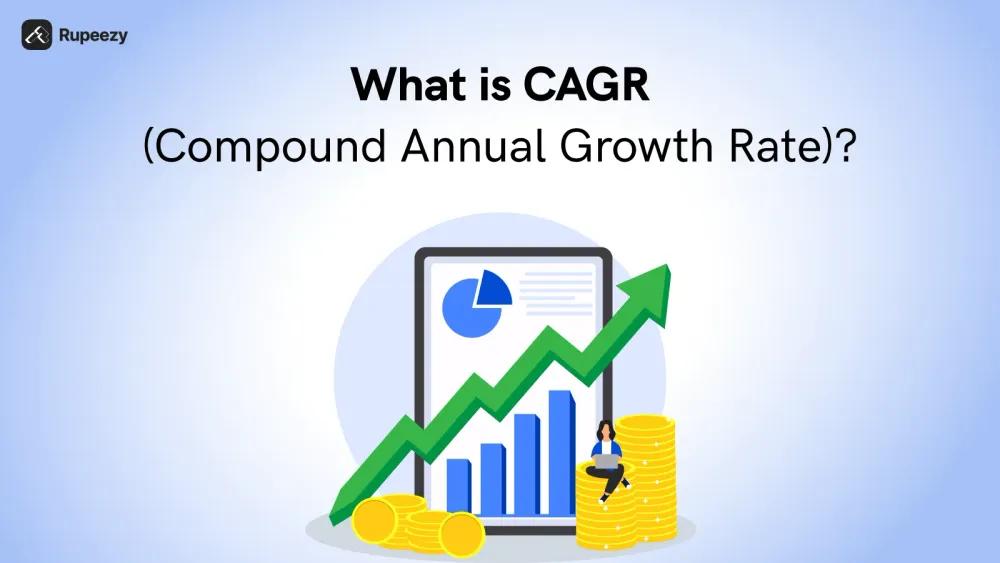What is CAGR in Mutual Fund - Formula And Calculation


00:00 / 00:00
If an investment grows from Rs. 1 lakh to Rs. 1.80 lakh in 5 years, then it is important to know how much growth has taken place on average every year. The most accurate way to measure this is CAGR, i.e., Compound Annual Growth Rate. In investments like Mutual Fund, SIP, Equity, or Debt Fund, CAGR helps in understanding the long-term performance. In today's era, CAGR has become an important parameter to evaluate investments.
CAGR Meaning And Full Form
CAGR stands for Compound Annual Growth Rate. It is a precise way of showing the average growth of an investment annually. Instead of showing the return for each year, it tells you what the investment would look like if it had grown at a steady rate every year.
A CAGR is used to understand the growth of an investment over a long period of time, i.e., how steadily a fund performed from start to finish. This metric does not just show numbers; it also reflects the quality and consistency of the investment. CAGR becomes a powerful parameter, especially when comparing multiple options.
CAGR has become an essential tool in mutual funds, stocks, and portfolio analysis, as it accurately shows returns with the effect of compounding.
Why is CAGR Important in Mutual Funds?
When it comes to investing in mutual funds, just looking at the returns is not enough. What truly matters is the consistency and continuity of those returns. CAGR reflects the consistency of returns, offering a clear picture of how a mutual fund has performed over time.
CAGR shows the growth rate of a fund year after year, regardless of the market fluctuations in between. This makes it easier to understand how much trust can be placed in the fund.
This is especially helpful when investors want to compare different schemes, be it a SIP, lump sum investment, or balanced fund.
Compound Annual Growth Rate has become a professional way of evaluating the performance of a fund, not just in numbers but in long-term investment behaviour, which can help in making more informed decisions.
How to Calculate CAGR (Compound Annual Growth Rate)
There is a specific mathematical formula for the CAGR calculation that determines the average annual growth rate of an investment over a fixed period.
CAGR Formula
CAGR = (Ending Value / Beginning Value) ^ (1 / n) – 1
Here,
Beginning Value = Initial amount of investment
Ending Value = Amount received on maturity
n = Number of years
Example of CAGR Calculation
Suppose a person invested Rs. 1,00,000 and after 5 years, that amount became Rs. 1,80,000.
So,
CAGR = (1,80,000 / 1,00,000) ^ (1/5) – 1
= (1.8) ^ 0.2 – 1
= 0.1247 or 12.47% per annum
This means that the investment gave an average compound growth of 12.47% every year.
CAGR vs Absolute Returns
Here is the key difference between CAGR and absolute return explained in simple terms:
Subject | CAGR (Compound Annual Growth Rate) | Absolute Return |
Meaning | The average rate of growth (compounded annually) that the investment makes | Total return earned over the entire investment period |
Formula | (Ending Value / Beginning Value) ^ (1/n) – 1 | (Final Value – Initial Value) / Initial Value × 100 |
Importance of time | Takes into account time and compounding | Doesn't look at time, only shows total growth |
Example | Rs. 1 Lakh ? Rs. 1.80 Lakh in 5 years = CAGR = 12.47% | Rs. 1 lakh ? Rs. 1.50 lakh = 50% Absolute Return |
When to use | When the period is more than 1 year, and stability of growth is required | When the period is short, and only the total profit is to be looked at |
Accuracy | More accurate and reliable in the long term | Useful in the short term, but gives limited information |
How CAGR Helps Track Your Investment Growth
Understanding investment growth through CAGR: CAGR (Compound Annual Growth Rate) indicates the average annual growth rate of an investment. It expresses the total growth received during the investment as a uniform annual return. This shows how steadily the investment has grown over time.
Useful for long-term investments: When the investment is held for a long period, the total return only shows the final amount but does not explain how the growth has been year after year. CAGR helps in understanding the actual annual progress of the investment.
Makes comparison of funds and schemes easy: It is easy to compare the performance of different mutual funds, SIPs, or other investment schemes through CAGR. It helps investors in making better decisions.
What is a Good CAGR for Mutual Funds?
Good CAGR in equity mutual funds: Generally 12% to 15% CAGR is considered good in equity mutual funds, as these funds are likely to give better returns with higher risk.
Normal CAGR in debt mutual funds: Debt mutual funds or fixed income funds have a CAGR of around 6% to 8%, which gives stable and safe returns due to low risk.
Better performance in the long run: If a mutual fund consistently gives a CAGR above 12% over a period of 5 to 10 years or more, it is considered a better performer.
Take care of new or short-term funds: The CAGR of short-term or new funds may be low, so it is important to keep in mind the time period and nature of the fund while investing.
How to Use CAGR to Compare Funds
Performance comparison with CAGR: CAGR shows the average annual growth of the investment, which makes it easier to understand the pace at which different mutual funds have grown in their respective periods. With this measurement, investors can understand their ROIC and compare the performance of funds in a better way.
Pay attention to other important aspects: Just looking at CAGR is not enough. It is also important to keep in mind the risk profile of the fund, the category of the fund (equity, debt, hybrid), and the investment period.
Look at the risk along with high CAGR: Some funds can have high volatility, so it is not right to make a decision only by looking at high CAGR. It is also important to understand the risk because CAGR only shows the average growth, not the level of risk.
Balanced approach for the right decision: Choose the investment option by combining CAGR as well as the stability, risk, and time period of the fund. This method helps in the direction of wise investment and better returns.
Role of CAGR in SIP, Equity, and Debt Funds
Role of CAGR in SIP: CAGR in SIP (Systematic Investment Plan) shows how much annual growth a monthly investment has generated on average over a long period of time. Although SIPs involve monthly investments, CAGR measures the growth rate of the entire portfolio when the value and duration of the portfolio are considered.
Importance of CAGR in Equity Funds: For equity mutual funds that invest in stock market, CAGR shows how stable growth the fund has generated annually despite market fluctuations. A 12–15% CAGR over a long period (5+ years) indicates good performance.
Role of CAGR in Debt Funds: Debt funds that invest in bonds and government securities have lower CAGRs but are more stable. A 6-8% CAGR is considered normal for these funds.
Example: If someone invested Rs. 5,000 per month through SIP for 5 years and the final value was Rs. 4 lakh, then CAGR will tell how much annual growth the entire investment gave on average.
Common Mistakes People Make with CAGR
1) Choosing an investment by looking at CAGR alone: Many investors choose a fund by looking at CAGR alone, but it does not indicate the stability of returns and risk. CAGR is an average rate that ignores volatility.
2) Comparing short-term CAGR: CAGR of 1 to 2 years is not very accurate as the market can fluctuate sharply during this period. For a better comparison, look at the CAGR of 3–5 years or longer periods.
3) Judging the performance of a fund by just one-year CAGR: Many people judge a fund as good or bad by just looking at the CAGR rate of the previous year, whereas one-year performance is sometimes temporary.
4) Comparing funds of different categories: It is wrong to compare equity and debt funds based on just CAGR, as both have different risk and return profiles.
Pro Tip: Use CAGR wisely, also keep in mind the risk, time period, and category of the fund.
Conclusion
CAGR, or Compound Annual Growth Rate, is a simple yet powerful way to understand the average annual growth of an investment. It not only reflects returns in a better way but also gives a clear picture of the sustainability and long-term growth of the investment. Be it SIP, mutual fund, equity, or deb,t CAGR is an important metric to understand every investment. So, while analysing investments, do not just look at returns but also at CAGR to make smart and strategic investment decisions.
FAQs
Q1. What is the full form of CAGR?
The full form of CAGR is Compound Annual Growth Rate, which shows the average annual growth rate of investment.
Q2. How is CAGR different from absolute return?
Absolute return shows only the total profit, while CAGR tells the average percentage growth every year.
Q3. Can I calculate CAGR for SIP investments?
In SIP, investment is made every month, so it is better to use XIRR in it. But if the starting and ending value and time are fixed, then growth can also be measured by CAGR.
Q4. Is a higher CAGR always better?
No, not always. If the CAGR is high but the fund is very volatile or has high risk, then it is not always the right choice.
Q5. What is a good CAGR for mutual funds?
For equity mutual funds, 12%–15% CAGR is considered good, while for debt funds, 6%–8% CAGR is normal.
Q6. Can I rely only on CAGR while choosing funds?
It is not right to depend only on CAGR. Risk, consistency, performance of the fund manager, and category of the fund should also be kept in mind.
Check Out These Related Articles |
The content on this blog is for educational purposes only and should not be considered investment advice. While we strive for accuracy, some information may contain errors or delays in updates.
Mentions of stocks or investment products are solely for informational purposes and do not constitute recommendations. Investors should conduct their own research before making any decisions.
Investing in financial markets are subject to market risks, and past performance does not guarantee future results. It is advisable to consult a qualified financial professional, review official documents, and verify information independently before making investment decisions.

All Category









